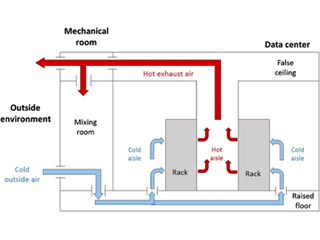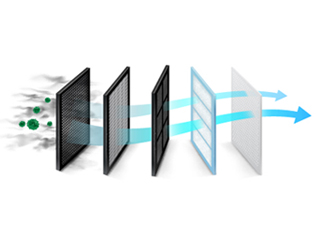AKCP thermal map sensors displayed in AKCPro Server
Data Center Temperature Sensors
Temperature sensors deployed in data centers monitor the environment the servers and IT equipment are operating. Ensuring the correct operating temperature, in accordance with ASHRAE recommendations is an essential element of data center management. The goal is to balance the cooling requirements of the IT equipment with the air supplied by the cooling system. Overcooling wastes energy, under cooling harms equipment and can lead to downtime. Humidity is controlled to prevent electrostatic discharges from occurring, or condensation forming. It is therefore a key element of the data center design to include provision for the proper placement of temperature and humidity sensors, as well as differential air pressure and airflow sensors.
In Rack Sensors
It is recommended to position temperature sensors at the front, top middle and bottom of the racks. Preferably no less than every 3rd rack in a row. In addition to the front, it is advisable to monitor the exhaust air temperatures from the racks. The reason for this is that monitoring the inlet air temperatures only does not give a complete picture. Sure, you may be generating cold air, but perhaps it is not moving through the racks at a sufficient volume to properly cool the equipment. The faster the air moves over the servers, the more cooling it provides. An insufficient airflow would show up as a higher than normal ∆T on your rack, through a high exhaust air temperature. The opposite could also be true, where over cooling leads to a low ∆T, which is wasteful and inefficient. Identifying such issues saves money through reduced downtime and maintenance, or lower energy costs through reduced cooling capacity.
In Room Sensors
While placing temperature sensors in racks is an excellent way to monitor performance at rack level, identify hot spots or cold spots, in room sensors give a more general sense of the environmental conditions in your facility. In room sensors are positioned away from areas that tend to have more fluctuations in temperature. Placement should be away from areas that are exposed to direct sunlight, or doors that are frequently opened or closed.
Sensor Thresholds
Understanding how to setup thresholds that trigger alarms is the next step in the setup of your temperature monitoring system. To do this, you must understand what the operating parameters of your data center are, and what constitutes an alarm condition. There are published specifications and recommendations from ASHRAE. For example the ASHRAE Energy Standard 90.4 published in 2019 outlines a framework for the design and operation of mission critical facilities such as data centers. It is recommended to operate between 18°C up to 27°C. The closer you are to the upper limits of this range, the lower your energy costs in cooling the facilities will be. However, this is a double edged sword, as the closer you are to this upper limit, the less margin for error there is. Therefore, a more comprehensive monitoring system should be in place to ensure correct temperatures are maintained. This makes it essential to monitor temperatures at a rack level, and carefully check ∆T’s.
AHSRAE’s guidelines go further than this general guide however. There are sub-classes of temperature ranges depending on the equipment type and classification. This classification runs from A1 to A4, where A1 is the strictest class, and includes enterprise servers and storage hardware, mission critical equipment. As you move towards A4 the requirements for control and operating temperatures becomes less stringent, with A4 classification being workstations and PC’s. There is a fifth class, H1, which pertains to high density server racks, and for this the recommended range is 18°C – 22°C although the allowable is from 5°C – 25°C.
The recommended temperature range is similar for each class, but the allowable range varies. The allowable range is the broad range in which the equipment can be expected to function properly, whereas the recommended is the range considered optimal for performance. So although it is theoretically possible as per the ASHRAE standards to operate A1 equipment at 32°C this would be generally frowned upon, and should not be considered as recommended.
So as you can see, it is important to understand your equipment and its optimal operating conditions before setting the thresholds for triggering alarms.
What is the Recommended Humidity for Data Centers?
Humidity, a measurement of the mount of moisture there is in the air. The Dew Point is the temperature at which water vapor held in the air condenses into liquid, assuming a constant pressure air pressure is maintained. ASHRAE provides guidelines on both of these measurements. A1- A4 class equipment recommended operating range is within a relative humidity (%RH) of 50-70% with a dew point of -9°C – 15°C. Again, an allowable range is also published, which is 8% – 80% for class A1 and 8% – 90% for A4. Allowable dew point is -12°C to 17°C.
Humidity Sensors
Like temperature sensors, humidity sensors should be placed throughout the facility, although less are required. Humidity values tend to be more uniform throughout the facility with less variations between each rack. Therefore, rack level humidity monitoring is not considered an essential requirement of the environmental monitoring system.
Monitoring Solutions
AKCP is the worlds oldest and largest manufacturer or wired and wireless sensors designed specifically for the needs of the data center. AKCP provides an end to end solution of both the physical sensor devices, and central monitoring platform, AKCPro Server, with DCIM features and over 40 years industry experience.
Thermal Map Sensors monitor the temperature at the top, middle and bottom, front and rear of racks with ∆T and Humidity values included. A total of 11 data points for a single rack. The inclusion of our Contactless Current Meter further enhances the function. All of this from a single sensor port makes a cost effective monitoring solution.
Individual temperature sensors, or combined temperature and humidity sensors are used at room level. With the combined temperature and humidity sensor the dew point is also calculated.
Additional sensors such as differential air pressure, airflow, water leak and power meters can be added as required.
The data collected is used not only to alert when things are going wrong. The sensors become an analytical tool through software such as sensorCFD




